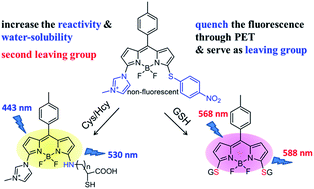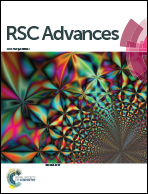BODIPY-based fluorescent probe for the simultaneous detection of glutathione and cysteine/homocysteine at different excitation wavelengths†
Abstract
We reported a BODIPY-based fluorescent probe for the simultaneous detection of GSH and Cys/Hcy. The nitrothiophenol moiety of the probe serves not only as a leaving group for the thiol-substitution reaction, but also a fluorescence quencher to provide a low emission background. The electron-withdrawing imidazolium group drastically increases reactivity of the Cys/Hcy-induced substitution–rearrangement reaction. The imidazolium group can further be replaced by GSH and resulted in a bithioether-product (λabs = 568 nm, λem = 588 nm), which showed distinct photophysical properties from the amino-product (λabs = 443 nm, λem = 530 nm) in the case of Cys/Hcy. It is noted that they exhibited great differences in absorption spectra of more than 120 nm. Thus, the simultaneous detection of GSH and Cys/Hcy can be achieved at different excitation wavelengths. The probe can quantitatively determinate the amount of Cys, Hcy and GSH in certain concentration ranges. We also found that the probe could detect GSH and Cys in living cells from different emission channels.


 Please wait while we load your content...
Please wait while we load your content...